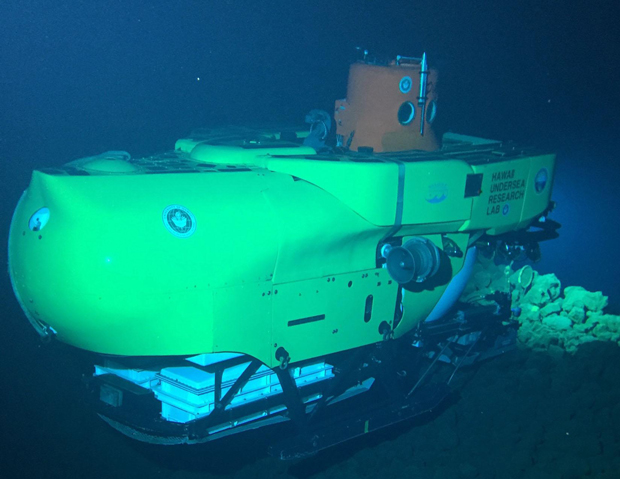
The Pacific Ocean has by far the largest number of seamounts, distinct features of volcanic origin that rise off the seafloor but do not break the surface, of any ocean on the planet. Earlier this month, the University of Hawaiʻi at Mānoa’s Hawaiʻi Undersea Research Laboratory (HURL) teamed up with the non-profit group Conservation International (CI) to dive on seamounts near Hawaiʻi—two of which have never been explored by human-occupied submersibles. Cook and McCall seamounts—part of the Geologists Seamounts, located 100 miles southwest of the Big Island of Hawaiʻi—and Lōʻihi were the destinations for this three-day series of dives using the Pisces IV and Pisces V, HURL’s two submersibles.
Prior to the recent expedition, limited surveys on Cook using remotely operated vehicles showed tall fan corals, a variety of deep sea hard corals, and other invertebrates. Very little was known about McCall.
To examine geological features and the rich variety of marine life, the team conducted video surveys and collected sediment, rock and water samples on each dive. They also used bait stations to draw close fish and especially deep sea sharks. Among the impressive volcanic formations, the team spotted such wonders as a rare Dumbo octopus with large fins that look like Dumbo’s ears at Cook Seamount, and a potentially new species of violet-hued coral they dubbed Purple Haze. At McCall Seamount, which is home to a large number of small deep-sea sharks, the team saw a purple chimaera.
During the last dive of the three-day expedition, HURL’s submersibles went into Lōʻihi’s pit crater for the first time since 2011. The submersible crews were able to survey familiar territory and make an updated assessment of the ever changing conditions in the bottom of the pit. They saw incredible basalt formations, rugged terrain and a very active vent system. The bait station set in the pit crater lured out a large, elusive Pacific sleeper shark.

Dive video highlights
A dumbo octopus (Grimpoteuthis sp.) swims on the Cook Seamount (filmed from UH HURL’s submersible). (credit: CI and HURL)
A purple chimaera swims near McCall Seamount (filmed from UH HURL’s submersible). (credit: CI and HURL)
A Pacific sleeper shark swims near Lōʻihi Seamount (filmed from UH HURL’s submersible). (credit: CI and HURL)

